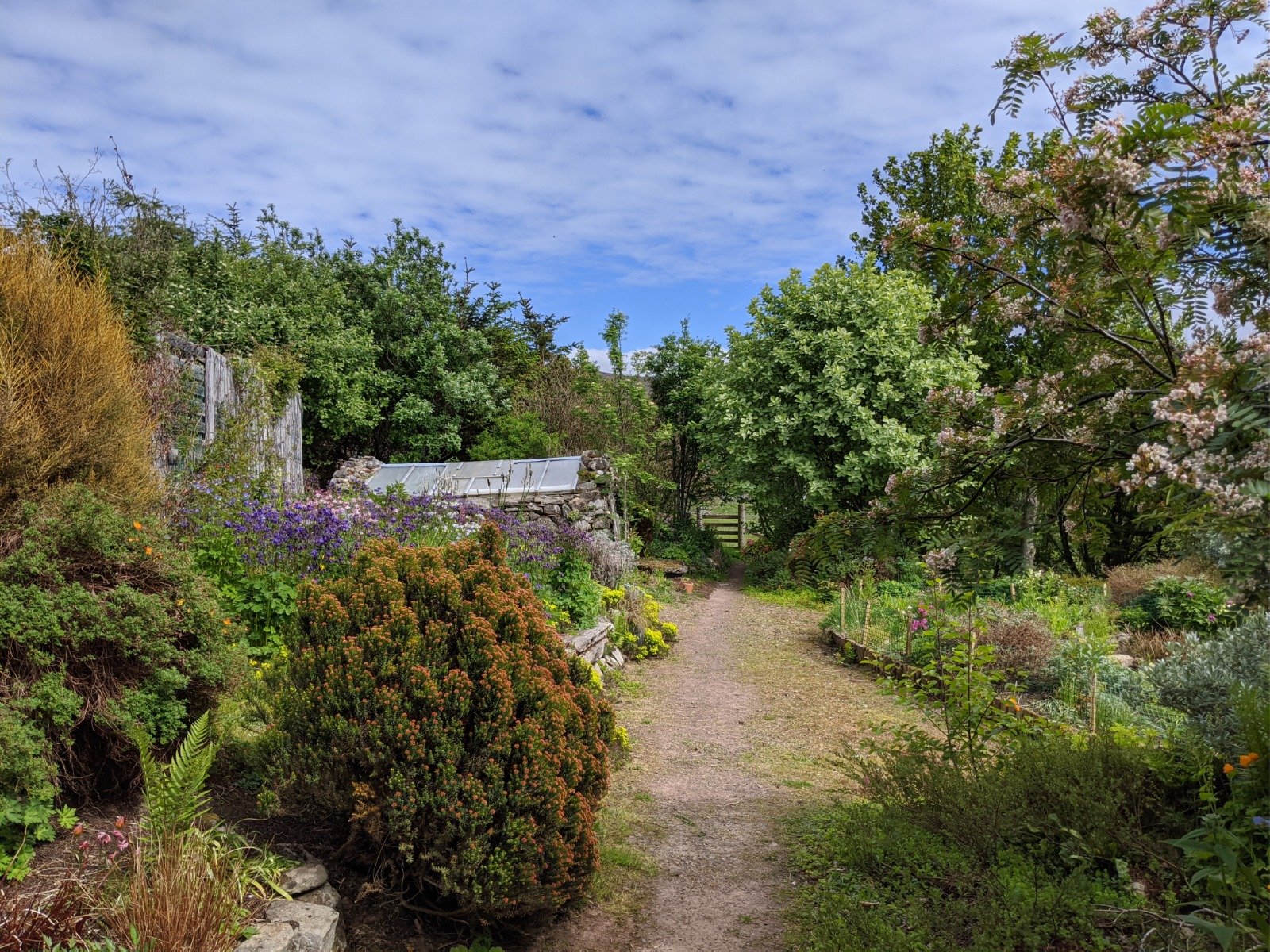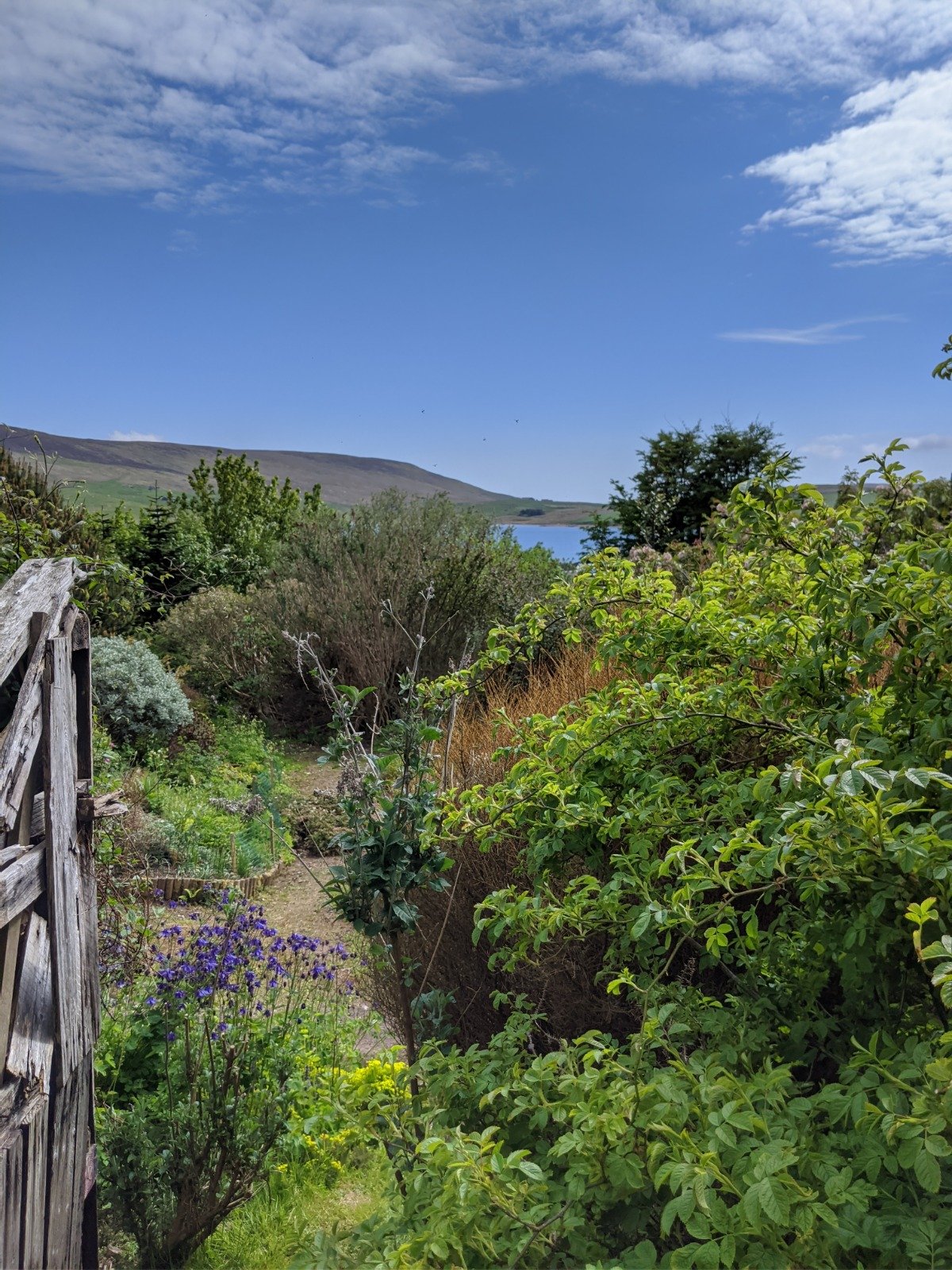Forest gardening at the top of the world
Raised beds sheltered by a mixed screen
of conifers and broadleaves. Photo: Rosa Steppanova.
Don’t let anyone tell you that Shetland is tree-less,
as Vishwam Heckert explains.
Just over a year ago, my partner Paul and I found ourselves wandering through magical gardens in the most unexpected of places. Paul had spent several blissful childhood years here in Shetland and yearned to return ever since his family moved back south. He brought me here, early in our relationship, about 20 years ago and I said, “I’m really sorry but it’s me or Shetland.” How could I live in a place with no trees?
But last year, after various adventures in trying to move into a more peaceful, cooperative and sustainable way of living, we came to Shetland to look for a home. After visiting the beautiful Bonhoga art gallery, we saw a sign for Lea Gardens and decided to have a look. We parked in the small car park by the sea and walked up a tree-lined drive to be met at the top by garden designer Rosa Steppanova herself. She apologised, saying the gardens were open by appointment only and seeing the disappointed look on our faces asked if we had been before. When we said no, she threw her arms wide with a great smile on her face and said, “Well, then you simply must see the gardens.” She showed us the donation box and guestbook and left us to wander at will.
Precious summer days and blue skies.
Photo by Paul Stevens
I was simply astounded by the rich density of growth, so unlike the heavily grazed terrain that characterises most of Shetland. It was incredibly reassuring to see that forest gardening is indeed possible here! We stayed for nearly an hour and a half exploring the three hectares of gardens—designed for wildlife and beauty—and met Rosa at the door of the croft house as we went to leave our offerings of gratitude in book and box.
She was surprised to find us still in the gardens and I said, “I never want to leave.” She laughed, saying they had plenty of room if we wanted to stay. Her partner James MacKenzie joined us to discuss ecopsychology, the links between therapy and social transformation and, of course, the delights of forest gardening. They invited us to lunch and then to house-sit for them and their beautiful gardens, giving us a foothold in Shetland life and the opportunity to learn directly from the gardens here.
Meet the pioneers
While Reforesting Scotland readers may primarily favour the return of native species, Lea Gardens serves as a reservoir of genetic diversity and a living demonstration of what an ecosystem of both natives and immigrants can offer Scotland. Rosa, James and I shared a lovely email exchange, although they are quite busy now preparing their place for sale. After devoting over 40 years of their lives to Lea Gardens, it is time for them to retire to warmer climes — in Fife!
Vishwam: What do you love most about Lea Gardens?
A rich habit for wildlife, including hundreds
of frogs every year. Photos: Paul Stevens.
Rosa: Every season there’s something different to love, really. In an island where there is little shelter from the winds and everything is exposed and visible for miles around, I love the seclusion and privacy that the garden here provides us year round.
Vishwam: What difference do you think Lea Gardens has made to the culture and ecology of Shetland?
Rosa: Lea Gardens was a pioneer project, starting in the days when it was considered impossible to grow trees, and much else for that matter on a rock sticking out of the Atlantic at 60 degrees north. There is no doubt that Lea Gardens played a significant role in changing this. Shetland has moved a long way from being a tree-less landscape. Ornamental gardens were few and far between when I started out in the late 1970s. That has also changed significantly—the Shetland gardeners’ Facebook page has over 3,000 members and new gardens are springing up all over the islands.
There have been tangible ecological benefits, such as the creation of micro-climates which prolong the growing season at both ends and therefore longer foraging times for pollinators and other insects. We’ve seen a marked increase in biodiversity which brings untold benefits to all.
Vishwam: Could you tell us a little about the importance of the shelter belt in Shetland? What species have been most helpful for you?
Vibrant and mature woodlands.
Photo: Vishwam Heckert.
James: The micro-climates are made possible by the creation of living shelterbelts, which filter and reduce the effects of wind. In Shetland that means frequent gales, often laden with a good dose of sea-salt. In Lea Gardens, we often have temperatures five or six degrees Celsius higher than outside. The only down-side to this is that we find ourselves shivering when visiting more exposed parts of Shetland, as we’ve forgotten about the wind-chill factor!
Nothofagus antarctica autumn foliage
Photo by Rosa Steppanova
When we started, almost the only available tree for shelter known in Shetland was the sycamore (Acerpseudoplatanus), which is not best suited to small gardens, and is quite slow to grow. In the last 25 years, however, new species have become available and are now locally propagated. Fast-growing willows (Alaskan felt-leaved willow, Salix alaxensis, and Hooker’s willow, Salix hookeriana), poplars (Black cottonwood, Populus trichocarpa) and alders (Sitka alder, Alnus sinuata) originating from the coastal ‘pan-handle’ of Alaska have proven to be very wind—and salt— resistant. These can be seen now surrounding many houses in the isles, and they have undoubtedly transformed the Shetland gardening experience.
Vishwam: Your first book, Rosa, was called The Impossible Garden. What have you grown that even you thought might be impossible?
Rosa: One specific plant springs to mind. I believe it was the early 90s when I first developed an interest in South American plants and fell in love with the Chilean firebush (Embothrium coccineum), a small tree or large shrub with stunning crimson flowers, their shape reminiscent of honeysuckle blossom.
Vishwam: How did Lea Gardens begin?
Pathway to possibilities
Abies Koreana (Korean Fir) in foreground
Photo by Vishwam Heckert
Rosa: During a Shetland holiday in the summer of 1976 I fell in love with the Shetland landscape, those endless green pastures and wide horizons so very different from where I had grown up in southern Germany, had me spell-bound. But then, as I moved here, I became more and more homesick and pined for the forests and gardens of the Spessart, the place of my birth. The Spessart is one of the oldest forests in Europe, containing oaks and beeches well over 1000 years old. I decided I could create something like my mother’s garden, and perhaps something remotely resembling a forest in Shetland. That’s how it all began...
Vishwam: What are your hopes for the future of Lea Gardens?
Rosa: Lea Gardens’ plant collection is my life’s work and I hope that there’s somebody out there who will be able to look after and possibly even enlarge the collection. There’s still a lot that can be done. Lea Gardens has immense educational potential.
Sheltered Glade in the garden
Photo by Rosa Steppanova
Vishwam: Do you have any advice for those of us who may want to start a forest garden in any of the windier and wilder parts of Scotland?
Rosa: When I started out I searched in vain for a manual on coastal gardening that actually dealt with my situation, rather than with the idyllic sea, sand, sun formula applicable to the south of England. As there is no such book, I had to write one myself. Called Gale Force Gardening, it describes over 1,700 plants suitable for marginal maritime climates and contains chapters on creating shelter, gardening for wildlife and lists of common names. It is due to be published by The Shetland Times later this year.
Vishwam: Is there anything else you might like to add for our readers?
Sea views
Photo by Paul Stevens
Rosa: There is no such thing as a site wholly unsuitable for gardening. Push at the boundaries and don’t be put off from making your dreams come true. Follow your heart and your instincts and you will find you can not only make the impossible possible, but inspire others to follow suit. Be a pioneer.
Vishwam Heckert serves as a yoga minister, teacher and trainer, as well as wellbeing coach and writer. He writes regularly for Bella Caledonia and has also published articles in Less: A Journal of Degrowth in Scotland and Permaculture Magazine, and more with poetry appearing in Sarasvati, Amethyst Review, and Earth Pathways, among others. You can find out more at flowingwithlife.org.
Rosa Steppanova is the author of The Impossible Garden (2004) and Gale Force Gardening (2022).
James Mackenzie has a Royal Forestry Society Certificate of Arboriculture and was the Project Officer for Woodlands at Shetland Amenity Trust, where he worked from 1990 until his retirement in 2016.
Paul Stevens is a professional ecopsychologist & hypnotherapist as well as an amateur photographer. You can find out more at wyrdwise.com.
This article originally appeared in Reforesting Scotland, Issue 66: Autumn/Winter 2022, pp32-34.








